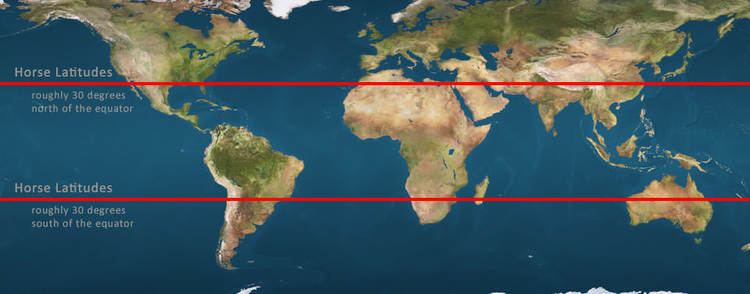 | ||
C6 pressure belts upsc ias trade winds easterlies westerlies horse latitudes formation of deserts
Horse latitudes or subtropical highs are subtropical latitudes between 30 and 38 degrees both north and south where Earth's atmosphere is dominated by the subtropical high, an area of high pressure, which suppresses precipitation and cloud formation, and has variable winds mixed with calm winds.
Contents
- C6 pressure belts upsc ias trade winds easterlies westerlies horse latitudes formation of deserts
- Horse latitudes
- Etymology
- References
The horse latitudes are associated with the subtropical anticyclone and the large-scale descent of air from high-altitude currents moving toward the poles. After reaching the earth's surface, this air spreads toward the equator as part of the prevailing trade winds or toward the poles as part of the westerlies. The belt in the Northern Hemisphere is sometimes called the "calms of Cancer" and that in the Southern Hemisphere the "calms of Capricorn".
The consistently warm, dry, and sunny conditions of the horse latitudes are the main cause for the existence of the world's major non-polar deserts, such as the Sahara Desert in Africa, the Arabian and Syrian deserts in the Middle East, the Mojave and Sonoran deserts in the southwestern United States and northern Mexico, all in the Northern Hemisphere; and the Atacama Desert, the Kalahari Desert, and the Australian Desert in the Southern Hemisphere.
Horse latitudes
Etymology

A likely and documented explanation is that the term is derived from the "dead horse" ritual of seamen (see Beating a dead horse). In this practice, the seaman paraded a straw-stuffed effigy of a horse around the deck before throwing it overboard. Seamen were paid partly in advance before a long voyage, and they frequently spent their pay all at once, resulting in a period of time without income. If they got advances from the ship's paymaster, they would incur debt. This period was called the "dead horse" time, and it usually lasted a month or two. The seaman's ceremony was to celebrate having worked off the "dead horse" debt. As west-bound shipping from Europe usually reached the subtropics at about the time the "dead horse" was worked off, the latitude became associated with the ceremony.
An alternative theory, of sufficient popularity to serve as an example of folk etymology, is that the term horse latitudes originates from when the Spanish transported horses by ship to their colonies in the West Indies and Americas. Ships often became becalmed in mid-ocean in this latitude, thus severely prolonging the voyage; the resulting water shortages made it impossible for the crew to keep the horses alive, and they would throw the dead or dying animals overboard.
A third explanation, which simultaneously explains both the northern and southern horse latitudes and does not depend on the length of the voyage or the port of departure, is based on maritime terminology: a ship was said to be 'horsed' when, although there was insufficient wind for sail, the vessel could make good progress by latching on to a strong current. This was suggested by Edward Taube in his article "The Sense of "Horse" in the Horse Latitudes" (Journal of Geography, October 1967). He argued the maritime use of 'horsed' described a ship that was being carried along by an ocean current or tide in the manner of a rider on horseback. The term had been in use since the end of the seventeenth century. Furthermore, The India Directory in its entry for Fernando de Noronha, an island off the coast of Brazil, mentions it had been visited frequently by ships "occasioned by the currents having horsed them to the westward".
